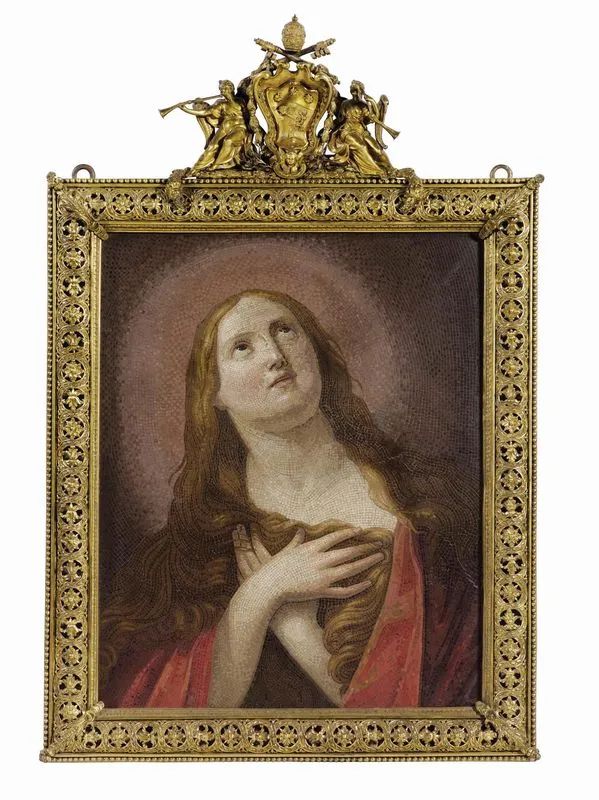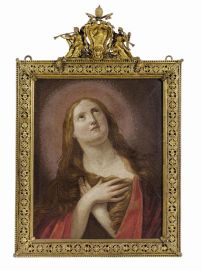Filippo Carlini
(active during the last half of the 18th century)
VATICAN MOSAIC STUDIO, ROME, 1777-1778, MARY MAGDALENE
micro mosaic on metal support, 74x59.5 cm
Paolo Spagna
(1736-1788)
FRAME, AROUND 1780
in gilded bronze, 111.5x76x10cm
A gift of the Pope Pius VI to the Archdukes of Milan
During the entire Eighteenth century, the papal court frequently made gifts, such as tapestries embroidered by the Papal Factory of Saint Michael1 and mosaic paintings executed by several artisans of the famous Vatican Mosaic Studio2, to sovereigns and illustrious guests during their official visits to Rome. In some cases, however, some of these artworks were commissioned to other mosaicists who worked in their own workshops. Therefore, these artworks achieved the highest technical perfection, rarely reached in the history of the mosaic, also thanks to the scientific knowledge of the infinite colour gradation acquired under the Pontificate of Pope Benedict XIII. The mosaics were often enclosed in richly decorated gilded metal (bronze, copper or brass) frames, skilfully created by goldsmiths working for the court. It is especially under the Pontificate of Pope Pius VI (1775-1799 fig. 1) that goldsmiths, such as the famous Luigi Valadier (who however rarely created similar objects) and in particular Paolo Spagna (1736-1788) gained more and more popularity.
Native of Rome, Paolo Spagna trained an entire generation of silversmiths and foundry workers, who were still active throughout the whole of the Nineteenth century. In 1772, he was granted a licence while living and working in his workshop in Via del Pellegrino. He worked as a papal court artist from 1775 until his death3. Some of his frames, to which, as we shall see, belongs the frame here examined, are already well known4. Made of bronze, copper, brass, gold, silver and iron, this frame is composed by a rectangular board with various decorations, carved in fretwork with phytomorphic elements and topped by a "Fame" (or a winged trumpeting Genius) on both sides of Pius VI's coat of arms. Its dimensions are 111.5x76 cm (88x76 cm without cymatium).
From the historical evidence found in the Vatican Secret Archive we learn what follows:
The mosaic
In February 1777, Giovanni Battista Ponfreni, Director of the Vatican Mosaic Studio, commissioned to Filippo Carlini (doc. 1) the reproduction in mosaic of the original Mary Magdalene depicted by Guido Reni. For this purpose, a copy of the portrait was painted as a model for Carlini, but it has unfortunately never been found (doc. 4). This painting was taken from Guido Reni's composition which, in that period, belonged to the Colonna Gallery: even if all traces of this original painting were lost, information about its existence is reported in many sources (fig. 2)5.
In December 1777 (doc. 1), Ponfreni reported that the work was proceeding and that one third of the total payment would be granted to Carlini. In March 1778 (doc. 2), the same amount of money was paid to the artist after Ponfreni's confirmation that two thirds of the panel had been completed. By the end of the same year Carlini finished the mosaic: for his work he received the total amount of three hundred and forty scudi. On December, 5 1778, the mosaic panel was transferred to the Floreria in the Vatican until the next opportunity to be offered as a gift (doc. 3).
Pupil of Marco Benefial, Giovanni Battista Ponfreni was born around 1715 in Rome where he died in 1795. Filippo Carlini was active around the second half of the 18th century in the Vatican Mosaic Studio and this frame is his only known artwork up to now6.
The frame
On April, 15 1780 (doc. 5), Paolo Spagna demanded the payment of two identical gilded metal frames for other mosaic paintings destined to the Archdukes of Milan: the first one depicting the Virgin of Sorrows and the lightly smaller second one representing Mary Magdalene.
As reported below, the document attesting the payment describes in detail every single element of our frame, as we can admire it today, together with the cymatium with the two "Fame" of which Spagna stated to have created a "wax copy". This statement is quite important because foundry workers were not often able to make models of their works. The document also specifies that the total amount paid for the frames by the Sacred Palace was 713:72 scudi, excluding the cost of the amount of gold used for the frames.
The mosaic depicting the Virgin of Sorrows was found in the storage of the Kunsthistorisches Museum of Vienna (fig. 3): unfortunately in the occasion of my publication in 2004, it lacked most of its frame. I was told that it had never been found. However, shortly afterwards, it luckily reappeared and was satisfactorily restored. It is identical to the Magdalene framework, albeit slightly larger, as specified in the already mentioned account of Spagna (doc. 5)7.
At the beginning of the 19th century, the workshop of Luigi Valadier and of his son Giuseppe passed on to the family of Spagna. The collection of the drawings, containing many sheets both of Luigi Valadier and of several other artists between the 18th and 19th century and linked to both Valadier's and Spagna's families, got lost under still mysterious circumstances.
The majority of these drawings are now in the Civic Gallery of Faenza while many others have been acquired in the last twenty years by many European and American art collectors through the Artemis Group of London. (It is worth reminding that the Artemis Group ceased its activity in recent times).
In the Valadier-Spagna collection of drawings there are several projects of frames and cymatiums aimed to mosaics for the Pope and similar to the one here analysed. Even if our frame is not shown in this collection, a drawing held in London (fig. 4) reproduces some similar "Fame", although together with a putto and intended for an oval frame.
An identical copy of the two frames, here examined, was made by Paolo Spagna four years later in 1784 as a gift from Pope Pius VI to the King Gustav III: the purpose was to frame a mosaic of Giovanni Battista Ponfreni depicting the figure of Diana taken from a painting of Guercino. This artwork was identified and can be admired today in the Nationalmuseum of Stockholm8 (fig. 5)..
The Archdukes of Milan
The document no. 5 dated 15th April 1780 contains a detailed description of two gilded metal frames for mosaic paintings: "one to be offered to His Royal Highness the Archduke of Milan and the other to His Wife the Archduchess, depicting the Virgin of Sorrows and Mary Magdalene respectively".
Together with the precise description of the decorations of the frames and of the figures, this document also mentions their dimensions: the frame containing Mary Magdalene was four palms high and three palms and five inches wide, corresponding to about 90 cm high and 76.9 cm wide. These measures are almost identical to those of our frame (without the two "Fame"). The dimensions of the Virgin of Sorrows are four palms and three inches high and three palms and six inches wide corresponding instead to those of the picture conserved today in Vienna (95x80 cm without "Fame").
The Archduke of Milan, mentioned in the document, was the son of the Empress Maria Theresa, Ferdinand Habsburg-Lothringen (1754-1806). In 1771, he married Maria Beatrice d’Este (1750-1829), last direct descendant of the Dukes of Modena. Ferdinand was Governor of the Duchy of Milan until 1796. In 1780, the Archdukes were in Rome where they received from Pope Pius VI the above-mentioned gifts.
Many years later in 1795, the Marquise Margherita Boccapaduli, who was one of the most educated women of her time and who belonged to a noble Roman family, describes the gifts of the Pope during a visit to the Royal Palace of Milan, residence of the Archdukes: "in one of the Archduchess' rooms, used as cultural salon, are hung the tapestries and the mosaics given by the Pope”9.
The two mosaics were certainly sent to Vienna where the so-called Palace of Modena (Modenapalais) was acquired by Beatrice d’Este in 1806. Many years later in 1859, her nephew, Francis V, Duke of Modena moved to this residence after his exile from his Italian Dukedom11. Francis V died in 1876 without heirs and named as his successor the Archduke Franz Ferdinand of Austria, heir to the Austro-Hungarian throne and assassinated in Sarajevo in 1914.
The two mosaic paintings of Pope Pius VI were therefore held in the Palace of Modena in Vienna until 1915 and were later transferred to the Kunsthistoriches Museum. In 1924, as a result of an agreement between the Austrian government and the legitimate heirs of the last Emperor Karl I deceased in 1922, the mosaic, here described, depicting Mary Magdalene returned to the Habsburg family. The back of the bronze frame still bears the original red mark with the inventory number E 783911. A similar mark with no. E 8627 can still be seen on the back side of the other frame depicting the Virgin of Sorrows at the Kunsthistorisches Museum.
1 A. De Suobel, Le arazzerie romane dal XVII al XIX secolo, Rome, 1989
2 L. Hautecoeur, “I mosaicisti sampietrini del ‘700" in L’arte, XIII, 1910, pp. 450 et seq.; A. Gonzalez-Palacios, Mosaici e pietre dure, Milan, 1981, I, pp. 4-35.
3 C.G. Bulgari, Argentieri, gemmari e orafi d’Italia. Roma, vol. ll, Rome, 1959, pp. 426-427. The son of Paolo, Giuseppe Spagna (1765-1839) carried on with his father's work after his premature death and received a licence in 1791: he continued to work for the papal court that later commissioned to the artist the creation of similar frames.
4 On this topic, see: A. Gonzalez-Palacios, Arredi e ornamenti alla corte di Roma, Milan, 2004, pp. 226-241
5 That painting is mentioned in a Colonna inventory of 1783 and was made by Domenico Cunego in 1776. Today this composition is known thanks to a copper autograph copy held in Versailles: S. Pepper, Guido Reni, Oxford, 1984, cat. 126, p. 262, fig.152. An exact copy of the here-mentioned painting made by Reni (size 66x58 cm) was recently shown at a Finarte auction held in Rome on 31st May 2006, lot. 269.
6 M.G. Branchetti, Mosaici minuti romani del 700 e dell’800, Vatican City, 1986, p. 174
7 A. Gonzalez-Palacios, Arredi e ornamenti cit., note 4. fig. 10 at p. 233. The dimensions of the frame of the painting in Vienna are 95x80 cm (with the two "Fame" is 123 cm high).
8 A. Gonzalez-Palacios, Arredi e ornamenti cit., note 4, p. 235, fig. 12
9 A. Giulini, “Milano e i suoi dintorni nel diario di una dama romana del Settecento” in Archivio Storico Lombardo, XLIV, fasc. 2, 1917, p. 360. There are no records of the tapestries.
10 F. Czeike, Historisches Lexikon Wien, Vienna, 1995, vol. 4, p. 281.
11 In the formerly typewritten inventory of the Kunsthistorisches Museum the following description is recorded, although still crossed: "1924 Mosaic image, portrait of Saint Magdalene ... Looking up, with her arms crossed over her chest. A bronze frame is surmounted by the Pope's coat of arms (Pius VI, Braschi 1775-1795) and two trumpeting angels. The composition is 113 cm high and 76 cm wide, Italian, second half of the 18th century. Origin: 1915 from the Palace of Modena. Identified with no. 7629 - handed over to Dr. Stritzl". Stritzl was the lawyer of the Imperial family.






















